Aesthetics of the Battlefield
Originally written in 2011.
Part 1: Distance, maps, optics and the art of spotting
Recently I got around to playing a few hours of Battlefield Bad Company 2 on PC. In short, BFBC2 is both a singleplayer, standard FPS as well as a large scale class-based multiplayer FPS. Comparisons will be made to other games. I have not played ArmA or America’s Army or very much of Operation Flashpoint so I will skip any references to them. My opinion is that they are fairly marginalized games and do not fall into the more established commercial sphere. This text concerns only the multiplayer aspects of BFBC2.
On the bigger scale, my fascination with (certain) FPS games, comes from the many complex readings that can be made around factors that are deeply game-centric, such as time, timing, pacing, death and respawning and the group/team structure in which they are commonly played.
BFBC2 is the closest thing commercial gaming has gotten to the dull experience of the Generation Kill kind of war depicted in, say, films. As has been asked by GameCritics (“Where is gaming’s Apocalypse Now?”), we may not yet be there, but in a fit of complete irony, we may be getting closer as “immersive” environments expand spatially. While the “horrors” of war are not depicted (more in part 2) the aesthetics, formation and systems are exposed. Movement and territorial gain is the metagame, every player’s radar the device to coordinate strikes.
Competing, but thematically similar games like those in the Modern Warfare series builds on the traditional twitch shooter legacy of games like Quake. While the games in the series have a multitude of play modes, much is still of the old-school variety. MW seems to be instantaneous in its firing, meaning there is virtually no time and space traversed when firing a gun: the bullets just stick to the target. This is not only a gameplay decision but most likely also a balancing issue because of networked physics or other calculations. First-time players will learn the hard way the intricacies of weapons usage in BFBC2.
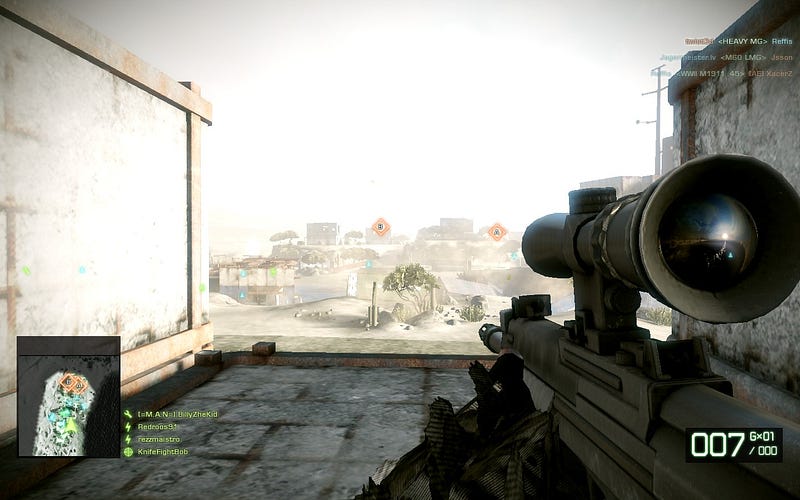
The spaces in-between zones of conflict, those areas that never truly form into ad hoc battlefields in their own right, empty voids containing debris, shipping containers, crop fields or just plain barren ground, are there to connect the consensual, approved and demarcated areas. Moving by foot over these areas takes time, rendering one helpless to the scopes of the enemy. It is almost a way of consistently rebuilding the slaughter at Normandie, repeating this pattern over most of the Rush type maps. Snipers spotting soldiers, a team-based visual effect, is essential for the rest of the team to move and navigate correctly. Markers are placed on spotted enemies so they can be found even if hiding. The hivemind of the team starts working collectively in a fashion strongly reminiscent of the Future Warrior project. Usually, after some time, someone starts infiltrating the perimeter and the conflict changes from long distance warfare to close quarters battles: more players switch to assault and support classes.
For the attacking players, more ammunition is spent firing into the distance, it being impractical and unsafe to cover all that land (distance) by foot, using the aid of a passing vehicle only if the opportunity arises. Warfare is a state that needs to be maintained: rather firing at impossibly distant targets than being subjected to the castrated loneliness and insecurity of the in-betweens. Without the aid of a vehicle, one is relegated to find cover while running towards the frontline. Modern Warfare, and the others, using a different field-of-view setting, emphasize broad 360 degree focus, quite different from the 55 degree narrow perspective of BFBC2. You can barely turn while sprinting, meaning you are always aiming for a defined location when running, rather than applying a hyperspeed boost to your abilities like in other similar games. The camera is focused on a goal or set direction, a voyeur of sorts that aims forward. Even the vast vistas and landscapes become geographies for hidden places and secluded spots. Horizons and contrasting backgrounds are located and deemed inappropriate for snipers because there snipers are highly visible. Once again, this does not rule out the off-chance that someone may order mortar strikes at that spot purely out of paranoia. Long distance warfare has no price — it is cheap and non-negotiable. No one will deny the legitimacy for bombing a few bushes, civilian houses or the horizon.
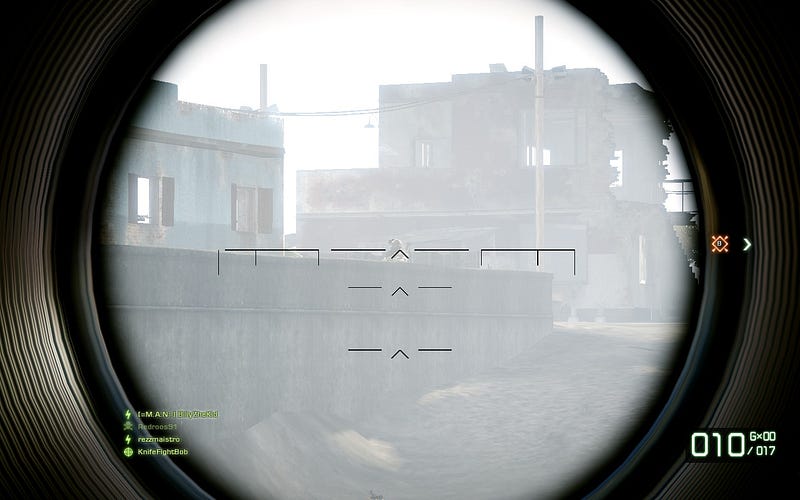
Getting closer to the frontline, a massive soundscape of heavy weapons fire creates a mood of impending death, far from the clinical silence of a game of Modern Warfare. There is no in-between audioscape, only the rattling of mostly small-guns fire when disjointed groups collide, evaporate and rejoin. The frontline of BFBC2’s Rush mode is probably the most intense war simulation that has been created in any FPS this far: As the smoke rises, multiple heavy weapons detonate and vehicles clash together, one is reminded of the relative insignificance of the single soldier. There is none of the personal hero-mythologizing that pervades the classic FPS games. No gun will ever save you from an airstrike or a tank.
Weapons are imprecise, single man raids suicidal and vehicles are impossible to effectively man alone. Firing at close range is usually extremely risky and damage is permanent. The trade-off to go in point-blank is so high, there is usually no reason to do so. Here is then the essential feature that separates BFBC2 from the other games: Cover is impermanent — it is used dynamically when needed, and battles are fought behind mobile covers (such as tanks) over medium distances. It would be easy to write about how BFBC2 becomes a dedicated military simulator by virtue of its tighter squad-based gameplay. I, however, think that is only a very small piece of what is going on.
So how do players know what to do at a given time? Where games like SWAT 4 make close-quarters combat and preliminary information and decisions a core tenet of its particular breed of gameplay, the ordinary FPS uses little of long-term informational holds, instead opting for a small set of direct, reflex keys to denote and connote state and place. Examples include the sound of an armor pickup in Quake and the pattern of spent pickups in the near-by environs. This is a staple of the flow-oriented, fixed-structure levels in most games. They are usually defined by their static qualities: maps do not change and they are constructed to facilitate movement. In direct opposition to this, BFBC2 uses impermanent structures to support resistance and wave formations rather than flow. We can therefore see the tendency of modern/guerrilla/fourth generation warfare emerging in the entertainment area. What I have refused to go into here has been ideology. The issue is obviously extremely interesting, but is something I may bring up later instead.
Part 2: Permanence, architecture, history, the other
This time we will direct attention to the places that make up a map and the people who use that land. Let’s start with a retelling of a recent round.
At the time I played as the sniper class and helped occupy a building that contained a mission objective. Line of sight is clear towards this building, perched on top of a hill. The map is set during a relatively dark winter evening. A road goes by the house: this is the main passage to the building. Another mission site is located obscured mostly by trees and foliage around 200 meters in a denser wooded area. Attacked as per usual by the enemy, together with the four or so other teamplayers we held the second floor and attic, laying down sniper fire and suppressive machine gun fire to halt them. An unknown but presumably larger quantity of assault class players were holding the downstairs entry points. We were doing very well. Because this is one of the first sites that the enemy forces will have to capture, the tempo is high since enemies start relatively close-by.
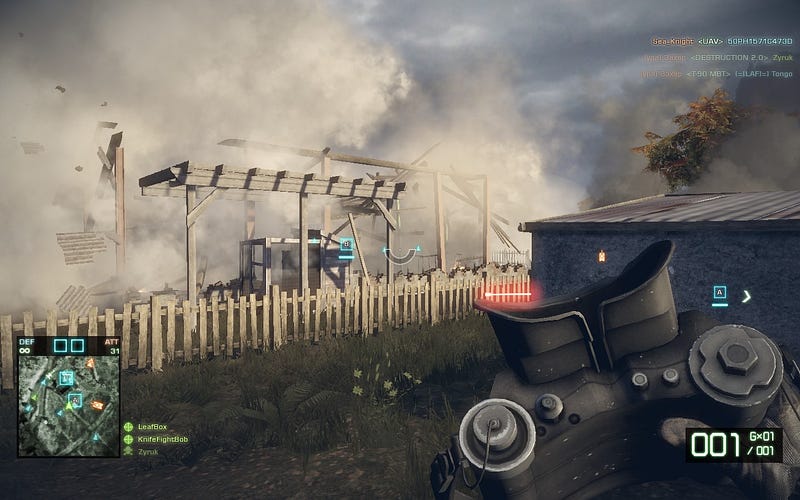
Several of the factors I’ve ruminated on were making their mark on that round. More experienced players have the choice of a range of class-based upgrades such as mortar strikes and team spotting markers. Thanks to this, senior snipers could spot-mark enemy locations further down the road. This in turn means that machine-gunners can suppress movement over open areas without worrying for too many hidden enemy snipers. Markers are indispensable in a confined space as the echoes are loud and shut out most of whatever one could hear from the outside. What happens is a changing act of balance and counter-balance between the active classes and the dynamics of their conflict (and statistics). We hit a sweet spot with that balancing and made sure to play it that way.
If you are familiar with FPS games you may think that what is happening is simple camping. I think it is more wise to see the enforced playstyle in a game like BFBC2 as a more intricate complex of player relations. The collective effort is central here. All available weaponry and specialization must be fully used to survive for any lenght of time.
Being declined close access to the building, the enemy forces began putting heavy long-distance fire on the attic whose only way of shooting in (and out) is through a small window. Because the room is dark a sniper inside will not be visible against a contrasting background which makes it a highly suitable, if predictable, spot. Also, this means only very few (at most two) can make use of the window. An impressive technical feature of BFBC2 is that practically everything is possible to destroy, meaning that there is physical scarring in the environments to show what happened in just that timespan. The game therefore takes cues from modern military tactics in how new paths can be created with demolitions, exposing or undermining enemy positions. The enemy fire, topped with rockets tearing down most of the slanting roofs, had the side-effect of not only revealing my team members, but also making the attic-located players capable of firing back en masse. Rubble and remaining wall sections provided little but useful cover.

As the game progressed increasing damage was made to our building with a quick decision to move downstairs as an airstrike was incoming. While there was no attic left, only open air above, the almost wall-less second floor become a powerhouse of resistance where teamplayers made effective use of medics and distributing ammunition to those who were running dry. All the time the team was reforming to the more and more shattered remains of the building. Because players are aware of the destruction they can also proactively engage enemies with heavy weapons and choose attack positions that are optimal based on current conditions. One might say that the resistance around the building was unstoppable and completely independent from the assistance of the occupants of the other mission site.
It should be abundantly clear that this way of playing is a far cry from the tunnel-based run-and-guns of yesteryear. Even more fine-grained choices like making shortcuts with explosives, clearing enemy resistance points by blowing up strategic points and using debris and smoke as cover exist but are not more than (just now) mentioned. Destruction becomes a way of being actively creative.
Now I want to return to the in-betweens from part 1 a bit and apply a broader perspective on this first section. The map we were playing contains mostly clearly defined non-civilian or military installations. Those buildings are large, unappealing, square and rectangle shaped concrete things. They are hard to destroy. But at the start of the map civilian-looking buildings are the targets. On many other maps, a much greater number of civilian structures come between the clashing factions. Is there then a history, even just an implied one?
What does speculative historicizing add to the game? Well, it makes it possible to think about the use value of the architecture in a civilian context. Does that house (the one on the hill in the winter night) fill a purpose? If it does, then who lived there, what did they do? Did they commute someplace or did they work near-by? Was the address exclusive or was it some reclusive hermit who used that house? If I was passing by car under different circumstances, what would these places reveal to me? Would I want to stay for coffee, looking at the views? Visiting the places of the deported, those places that haunt the vast landscapes that are increasingly devastated by mortar fire and tank battles, countless deaths and helicopter raids ending in airborne, burnt-out missiles falling to the ground, leave a strange feeling. Houses, garages and seemingly temporary housing like sheds are there merely architecturally but are strangely devoid of anything that might humanize them. Of course we may go into some detail on why it serves good hardware practice not to insert a million different small objects in a networked environment. Regardless of practicalities, the stripped-down aesthetics of war in Battlefield are at odds with the punishing difficulty of its gameplay.
This is probably where BFBC2 is — not — the Apocalypse Now of gaming. There is no third party suffering, only the surgical, masochist warfare of almost infinite prejudice. It is as if the enemy was so clearly cut-out that the civilians were never there, there being no more modern grey areas, no terrorism and only the pure, undiluted battle(field)s of the 1700s. Buildings explode, collapse and are rebuilt for the next round. But no-one seems to have lived there: the places are mostly industrial-type locales like building sites and ports. No one is missed, or at least I can’t get to grips with what I am supposed to feel about it. The population is displaced and their former habitats are now only playgrounds for Battlefield’s Destruction 2.0 (yes, it’s called so). I am concerned with this fetishization just because I have a deep respect for the effort put in the rest of the game experience. The contemporary warfare meets a distanced old-fashioned closed space. In short, killing an accepted, non-political enemy where no one else gets hurt. No enemies but these other men. Interestingly the uniforms are not even that very distinct. Technology (markers) are often the only way of seeing the difference between friend and foe. What if the tech overlay started lying?
When a building crumbles I think of the indistinct person who paid the monthly mortgage for the privilege of living there. Or am I overthinking it? After all, the rooms are empty, no pictures hanging on the walls. No china in any cupboards or old cars that have been lovingly taken care of in garages with neatly ordered tools. The closest thing that comes to mind is the first episode of Twilight Zone (“Where is everybody?”) where mysteriously no one is to be found anywhere. The non-existing inhabitants here must be either figments of the player character’s imagination, merely alluded to, or they have been transferred.
What would happen if players could use the fully equipped civilian houses as shelter? What happens when a soldier enters a new apartment and starts firing out a window from which he has never leaned out of, smelling the fresh crisp autumn air? Does respect of other’s living quarters, personal belongings and in turn mannerisms deny the impersonal shelterization and practical military use of that space? Is there a border that needs to be crossed before one can walk into someone’s place with boots on (I’m European-Swedish, meaning this means something different to me than it may mean to you) just to take a few potshots at others outside?
Part 3: Death, rebirth, identity/class, “optimal life span”
Let’s start with the “stray bullet theory”.
The way of dying I acted and reenacted so many times is something that seems to have grown in occurrence in later years. That way is what I call “death by invisible and/or stray bullet”. Play styles change to accommodate the higher number of inaccuracies, variable conditions and to simply keep oneself alive under stressful conditions. As has been written earlier, gone are the days of full auto machine gun fire in other than the most survivalist moments. In short: in the most unexpected moments, you find yourself immediately dead from something you could never have foreseen or expected. Games have had a few major systems for health and its representation over the years, and the more contemporary ones are self-regenerating health (which is low as to not become unbalanced) and different ‘hardcore’ varieties where health is a relatively life-like thing where low health is coupled with permanent damage and medical aid. This is the one Battlefield Bad Company 2 uses. As an effect of health being in short supply, any mistake, even small, can be the grain of sand that tips the scales in the enemy’s favor. In the end, the enemy’s sporadic, defensive firing into blind spots could mean your death, ergo, death by stray bullet — it was never directly (but indirectly) meant to hit something.
This is an effect of a total war scenario that focuses on collaborative pushes instead of heroic determination. The occlusion of positions, variable lines-of-sight and rapid redeployment/regrouping increases stress levels and paranoia. In any given moment (remember, this is all a complex matrix of locative/spatial and temporal factors) all vectors and directions cannot be covered by the narrow slit of the camera-eyes. Players get nervous as the noise and chatter increases in volume and particle effects spread from collapsing buildings, further covering the milieux and environs. A quick look at the map reveals positions of friendlies meaning it is safe to shoot into dust clouds or spray at random into windows that may contain a spotter — if there is a spotter he may immediately fall prey to a seemingly random swarm of bullets. BFBC2 has a good number of those random moments where players can’t expect death but always should. Paranoia increases and the number of stray bullets fired grow exponentially. One learns to accept this over time. Death is thus cruel and random at many times.
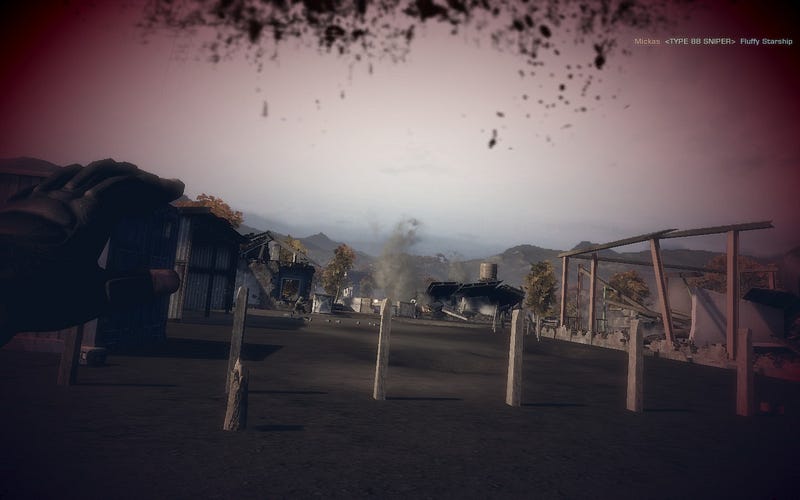
Oh, and you are a man when you die. Always a man. There exists no women, civilians and terrorists on this, or any I would argue, digital battlefield today. No grey lines. Only total, punishing war and the beauty of collapsing buildings. Masks often hide the faces, shooters becoming anonymous, technology and face-gear hiding the human beneath. Because of the lack of the physical ‘Other’, there is no shame in killing. There are no hard and fast questions posed when encountering an enemy. The masculine tone of the game is not challenged either by introducing the other sex(es), or even notable age differences. There is no depth to the avatars because they only portray the image of war, the carriers of death rather than the fully-fleshed characters of the great war films. Truly this is a clear case of how avatarism differs strongly from characterization: the avatar is only a body without organs, it is shallow, lifeless and only the container that holds the hitbox at which you aim and shoot.
The collective effort has many interesting side effects. When you die, you are usually shown a view that shows your killer and what (s)he is doing right now. Then, you are shown a map of the area and can choose to ‘respawn’, that is be reborn, at one of the 2 current key locations or straight at the location of any surviving squad member. This often saves lots of time traveling over the hazardous in-betweens. Life and death circulates around this penultimate position of all-seeing eye: seeing the killer (sometimes dying immediately thereafter when exposed after killing you) and being able to manipulate your continued cycling of existences. Your body is a beacon for others to re-enter combat and your one true calling.
Your true call is simple. You are born into the service of the military. Your weapon is so obviously the centerpoint that it is always there in your hands from birth. It has practically been melded into your skeleton. Sometimes you will make a physical scar in the haunted lands by throwing a few grenades around just to celebrate that you are back, or possibly just to enjoy the scattering of cement and wood splinters. It is optimal usage of inventory to use your equipment, especially if you expect to die soon. It is martyrdom walking hand-in-hand with cynical rationalism. You can always say you were smoking out the enemy from their hiding places if you happen to put holes in friendly placements.
But what if you started unarmed, with weapon holstered, ready at the press of a key but not directly available? The cycle of life and death can be meta-physically reflected, and the (un)certainness of the current situation can be a selfish (?) signal to not spawn by your comrades sides. Your squad is dead and the game signals this by sending a message that you should stay alive because they are counting on you, or some similar such thing. When they die you have to live to carry on the fight, just as they did for you just now. The beacon of your body must continue to shine if but for a very brief period of time until they can use you as a vehicle to be transported back into certain death. You should probably hide to provide cover for the yet unborn. A man has now become the mother of martyrs.
Your squad members are thus passed into the timed respawn system, the dharma wheel turning and releasing its contents in regular intervals. It is stable, not ending until the tickets are spent. It is an economy of lives where there is no repercussions for having negative kill-death ratios (“KDR”). A negative KDR means that someone has died more often than they have killed others. It is sometimes more practical being a ruse or shield, expecting low KDRs just for spending enemy time. It is not unlikely to think this way when death means almost nothing. The only implication is that your post-game score which is used to unlock new upgrades and weapons is lower than it could have been, had you played simply to slaughter the enemy. BFBC2 seems to imply that life is a process that always ends with some, if meager, progress towards betterment. You contribution may mean the team’s victory while it is still a personal ‘defeat’ of sorts. Life is something we can start measuring by a value given the name of ‘optimal life span’. Life does not by itself mean progress, awards or good team standing if you are but walking in the distant groves far away from the battle zone.
So, now you are dead. There was no blood where you fell, only the clinical falling over of the ragdoll after the near-simultaneous particle puffing of an enemy rifle. If, and when, you decide to go back into action sometimes you will have to wait, sometimes you are almost immediately back. If the adrenaline is still kicking in, an early re-entry could mean certain annihilation. Team tickets are spent wastefully and enemies can see an emerging pattern continuously repeating itself. Over and over again, the same man comes over the same hill. Or is it the same man? They all look the same. The enemy’s ammunition is becoming depleted, yet the freeze frame of the corpse is there if in uneven arrangements of ragdoll physics bodies. The great battlefield devolves into the multi-perspective, variable private tower defense of two players, one rushing in and the other defending. Death is not glorious but loud, expensive and often abrupt. It becomes private the moment the same player shoots you in the face five or so times. Then he is marked your nemesis. You are awarded more score if you kill him then.
You were wasteful again. You should have listened to your teammates. You should not have spawned on your squad when you saw that the enemy offensive was so strong. You could have planned it better. Now your score is negative. But it doesn’t matter: the next map is waiting. Perfect asymmetry of buildings not yet destroyed, roads not yet torn with tank tracks and places waiting for corpses vanishing into thin air after a few seconds. A new postcard view of remote un-populated villages waiting for the intense cycling/recycling of lives. The only thing that is taboo here is blood, because that would mean people die here. Life prevails and death means nothing on the battlefield.
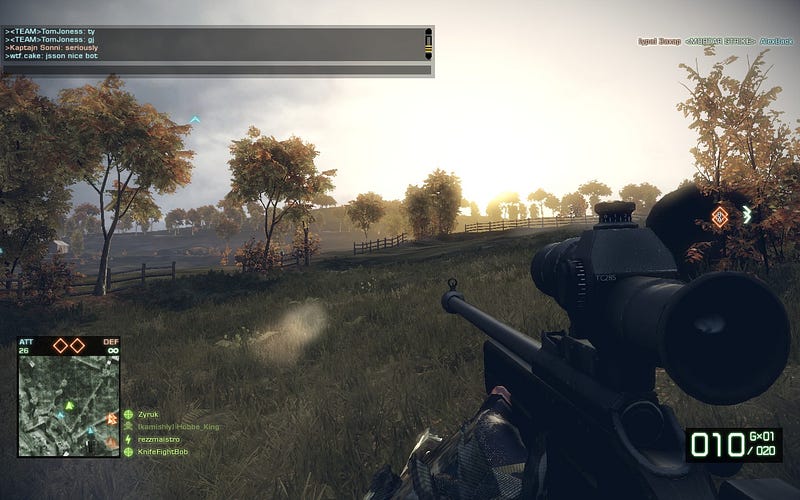
Because a game like BFBC2 is almost always experienced in outdoor environments, a sniper will often be scoping you and waiting for a good moment to fire. It is in the nature of digital war to always be observed. However, the vast distances make the bullet fall over time, making marksmanship an actual implemented detail rather than merely pointing and shooting. The simulation seems rather simple but offers a much heavier feel to sniping than in a game like Modern Warfare. The stray bullet theory however has nothing special to do with camping or bullet physics.